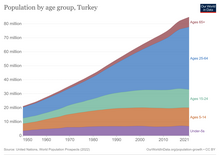|
Health in Turkey
 The healthcare system in Turkey has improved in terms of health status especially after implementing the Health Transformation Program (HP) in 2003.[1] "Health for All" was the slogan for this transformation, and HP aimed to provide and finance health care efficiently, effectively, and equitably.[2] By covering most of the population, the General Health Insurance Scheme is financed by employers, employees, and government contributions through the Social Security Institution.[1] Even though HP aimed to be equitable, after 18 years of implementation, there are still disparities between the regions in Turkey. These discrepancies can be seen in terms of infant mortality between rural and urban areas and different parts of the country, although these have been declining over the years.[3] While the under-5 mortality rate in Western Marmara is 7.9, the under-5 mortality rate in Southeastern Asia is two times higher than Western Marmara, with the rate of 16.3 in 2021.[4]  In 2022, the population of Turkey calculated at more than 85 million by showing the trend in the population of old people increasing.[5] The causes of the changes between population pyramids in 2007 and 2022 are that the fertility rate decreased from 2.16 to 1.62[5][6] and the life expectancy reached 78.3 years between 2018 and 2020 in Turkey.[7] The Human Rights Measurement Initiative[8] finds that Turkey is fulfilling 81.6% of what it should be fulfilling for the right to health based on its level of income.[9] When looking at the right to health with respect to children, Turkey achieves 95.5% of what is expected based on its current income.[9] In regards to the right to health amongst the adult population, the country achieves only 92.0% of what is expected based on the nation's level of income.[9] Turkey falls into the "very bad" category when evaluating the right to reproductive health because the nation is fulfilling only 57.3% of what the nation is expected to achieve based on the resources (income) it has available.[9] As of 2023 health impact assessment is not done in Turkey.[10]: 50 Turkish health system  Health services in Turkey are controlled by the Ministry of Health through a centralized state system. In 2003, the government introduced a comprehensive health reform program aimed at increasing the budget rate allocated to healthcare services and ensuring that a large part of the population is healthy. The Turkish Statistical Institute announced that it had spent 76.3 billion TL in health services in 2012; the Social Security Institution covered 79.6% of the service fees while the remaining 15.4% were paid directly by the patients."[11] According to 2013 figures, there are 30,116 health institutions in Turkey and per one doctor there are an average of 573 patients. In addition, the number of beds per 1000 people is 2.64.[12] Life expectancy in Turkey is 75.6 years for males and 81.3 years for females, and the life expectancy of the total population is 78.3 years.[7] The three most common causes of mortality in the country are cardiovascular diseases (35.4%), cancer (15.2%), respiratory diseases (13.5%).[13] Healthcare in Turkey is majorly provided by Ministry of Health and some private health institutions.[14] Primary healthcare systemThe Turkish Public Health Association is accountable for the primary healthcare delivery in Turkey.[14] Services[15] that are managed, developed and supervised by the Public Health Association are (health related units): Primary Health Care Services
Communicable Diseases Control Programmes
Non-communicable Diseases Programmes and Cancer
Occupational Safety and Environmental Health UnitPublic Health LaboratoryMaternal mortality ratio  According to the WHO data between the years 2000 to 2017, Maternal mortality ratio (MMR) in Turkey has decreased from 42 to 17 in 17 years.[16] In 2010, Turkey was nearly on par with some of the other OECD countries such as South Korea and Hungary and had a lower maternal mortality ratio than the United States.[17]
Under-five Mortality Rate (U5MR)Turkey's U5MR in 2021 was reduced by 88% over 1990 levels, while in the rest of the world the total reduction was %59 between 1990 and 2021.[18] Even though Turkey has accomplished to reduce U5MR, it has always been higher than the Europe and Central Asia averages between 1990 and 2021.[18]
Causes of deathThe top 5 causes of death are cardiovascular diseases (35.4%), cancer (15.2%), respiratory diseases (13.5%), endocrine and nutritional diseases (4.5%), and others (13%).[13] When the diseases causing death are examined on a gender basis; deaths from circulatory and endocrine diseases were found mostly in women and deaths from cancers and external causes were seen in men.[4]
NCDs already account for over 89 percent of all mortality in Turkey.[19] Top ten causes of deaths in 2019[19] from the most causes to the least are:
However, combining death causes with disability causes is changing the top ten list and, it includes low back pain, neonatal disorders, depressive disorders, headache disorders, and gynecological diseases.  The risk factors the drive most death and disability in Turkey are tobacco use, high body-mass index and high blood pressure.[19] WHO estimates that 42% of men are tobacco smokers.[20] "Multisectoral action plan of Turkey for non-communicable diseases 2017–2025"[21] has been established by the Turkish Ministry of Health in order to halt and manage the NCDs in Turkey. The action plan[21] is coordinated with the Sustainable Development Goals. Obesity and Dietary Behaviors One of the risk factors that causes death and disability is a high body-mass index, which increased the DALYs (per 100.000) +453.9 between 2009 and 2019 in Turkey. The other risk factors that are on the top ten list, many of them related to eating behaviors.[22] Turkey has the highest rate of obesity in the WHO European Region; according to the European Obesity Report 2022 by WHO, more than 65% of adults are overweight or obese in Turkey.[23] Further, obesity in females (39.1%) is higher than in males (24.6%).[24] The increased prevalence of obesity in Turkey is attributed to the changes in dietary behaviors. Turkish people eat fewer grains, bread, vegetables, and fruits than before. This causes an increase in fat intake and energy percentage from fats and a decrease in vitamin C intake. Although the energy and macronutrient intakes are within the recommended ranges (carbonhydrates: 50%, protein: 15%, and fat: 35%),[24] it is seen that the diet of Turkish people has shifted to a Western-type diet in terms of micronutrients and food groups.[25] Additionally, one of the determinants of obesity is urbanization in Turkey due to sedentary lifestyle in the cities, availability of public transportation, working more at office jobs, and changes in social and economic structure. Migrating to big cities is popular and causes high unemployment rates, which might also cause less physical activity.[26][27] The other social determinants of obesity are being married and having a lower educational level in Turkey.[28] A lack of knowledge about health and the health consequences contribute to the high percentage of excessive weight.[27] Obesity and being overweight is higher among women for several reasons. A majority of women do not have jobs outside of the home and lead more sedentary lifestyles as a result. Housework is often the only source of physical activity for women, as there is no prior tradition of women participating in sports.[27] "Turkey Health Nutrition and Active Life Program (2014–2017)" is implemented by the Ministry of Health in Turkey in order to prevent obesity and reduce obesity-related diseases (cardiovascular diseases, diabetes, some types of cancer, hypertension, and musculoskeletal diseases) by encouraging people to have adequate and balanced nutrition and regular physical activity habits.[29] In 2019, the Ministry of Health in Turkey extended the program and introduced the "Adult and Childhood Obesity Prevention and Physical Activity Action Plan (2019-2023). One of the actions in the program addresses the decreased purchasing power problem in Turkey by minimizing inflation on healthy products such as fish, milk, fruit, and vegetables and taking actions to increase purchasing power.[30] In 2022 half of children ate fruit every day, and a third ate vegetables every day.[31] Placing fruit and vegetables outside shops attracts customers.[32] In 2022 a lawsuit was started claiming that the ban on vegan cheese was unconstitutional.[33] Sugar beet is subsidized.[34] Diabetes Diabetes causes 2% of total deaths in all ages in Turkey.[35] Furthermore many more Turks die from Diabetic Kidney disease, a complication of Diabetes and non-diabetic High blood sugar, and some say that the consequences of Diabetes could cause up to 20% of all deaths in Turkey.  In 2016 it was estimated that 13.2% of the population had diabetes and there is an increasing trend in the prevalence of diabetes.[35] The main cause of this could be the fact that over Nearly 2 in 3 Turks are overweight and that 1 in 3 are obese. Diabetes has been described as "one of the top priorities" for the Turkish government.[36] An operational action plan for diabetes, overweight and obesity exists as a national response to the diabetes.[35] Air pollution and climate change Air pollution in Turkey is estimated to be a cause of 8% of deaths in 2019.[37] Coal is a major contributor to air pollution, and damages health across the nation, being burnt even in homes and cities.[38] It is estimated that a phase out of coal power in Turkey by 2030 instead of by the 2050s would save over 100 thousand lives.[39] Climate change in Turkey may impact health, for example due to increased heatwaves.[40][41] Vaccine-preventable diseases Vaccines that are on the existing immunization schedule of the government are free of charge. According to the recent 'WHO vaccine-preventable diseases: monitoring system' reported cases for Diphtheria were 0, Measles were 9, Rubella were 7, Mumps were 544 and Tetanus(total) were 16 cases in 2016.[42] Immunization schedule
HIV/AIDS in TurkeyBetween 2006 and 2017, new HIV infections increased by 465%.[43] AIDS is a disease that is not decreasing as in much of the rest of the world. Analysis of nearly 7000 cases reveal data about HIV in Turkey.[44] AIDS in Turkey is often described as a "Gay disease", "African disease", or "Natasha disease",[45] so people tend to hide their illness. "According to the United Nations HIV / AIDS Theme Group's 2002 HIV / AIDS Situation Analysis report in Turkey, between 7,000 and 14,000 people have been infected with AIDS since the beginning of the pandemic. Figures released by the (Ministry of Health) in June 2002 show that a total of 1,429 HIV / AIDS cases had been reported since 1985."[46] Due to problems in the registration and notification system, obtaining reliable numerical information about AIDS cases is very difficult in Turkey.[47] "The disease is seen in 20-45 groups. It is estimated that approximately 2,000 people have been treated with this disease in Turkey. Marmara region where the most case report is made to the current. These are followed by Ankara, Izmir, Antalya, Mersin, Adana and Bursa respectively. Foreign nationals who make up about 16 percent of cases are from Ukraine, Moldova and Romania."[48] 2009 swine flu pandemic in TurkeyThe 2009 flu pandemic was a global outbreak of a new strain of influenza A virus subtype H1N1, first identified in April 2009, termed Pandemic H1N1/09 virus by the World Health Organization (WHO)[49] and colloquially called swine flu. The outbreak was first observed in Mexico,[50] and quickly spread globally. On 11 June 2009, WHO declared the outbreak to be a pandemic.[51][52] The overwhelming majority of patients experience mild symptoms",[51] but some persons are in higher risk groups, such as those with asthma, diabetes,[53][54] obesity, heart disease, or who are pregnant or have a weakened immune system.[55] In the rare severe cases, around 3–5 days after symptoms manifest, the sufferer's condition declines quickly, often to the point respiratory failure.[56]  The virus reached Turkey in May 2009. A U.S. citizen, flying from the United States via Amsterdam was found to be suffering from the swine flu after arriving at Istanbul's Atatürk International Airport.[57] Turkey is the 17th country in Europe and the 36th country in the world to report an incident of swine flu. The Turkish Government has taken measures at the international airports, using thermal imaging cameras to check passengers coming from international destinations.[58] The first case of person to person transmission within Turkey was announced on 26 July 2009. On 2 November, the Turkish Health Ministry began administering vaccines against H1N1 influenza, starting with health workers.[59] After a slow start, the virus spread rapidly in Turkey and the number of cases reached 12,316. First death confirmed on 24 October and death toll reached 627.[60] COVID-19 pandemic in Turkey The COVID-19 pandemic in Turkey is part of the ongoing COVID-19 pandemic caused by severe acute respiratory syndrome coronavirus 2 (SARS-CoV-2). The disease was confirmed to have reached Turkey on 11 March 2020, after a man who had returned to Turkey from Europe, tested positive.[61] The first death due to COVID-19 in the country occurred on 15 March 2020 and by 1 April, it was confirmed that COVID-19 had spread all over Turkey.[62] On 14 April 2020, the head of the Turkish Ministry of Health Fahrettin Koca announced that the spread of the virus in Turkey has reached its peak in the fourth week and started to slow down.[63] The disease is exacerbated by air pollution,[64] for example from burning coal in Turkey for residential heating.[65] As of 22 July 2020[update], the total number of confirmed cases in the country is over 222,400. Among these cases, 205,200 have recovered and 5,500 have died.[66] On 18 April 2020, the total number of positive test results surpassed that of Iran, making it the highest in the Middle East.[67][68] Turkey also surpassed China in confirmed total cases on 20 April 2020.[69] The rapid increase of the confirmed cases in Turkey did not overburden the public healthcare system,[70] and the preliminary case-fatality rate remained lower compared to many European countries.[71][72] Discussions mainly attributed these to the country's relatively young population and high number of available intensive care units.[73][74] See alsoReferences
|